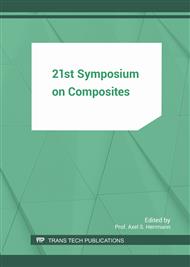p.3
p.9
p.17
p.25
p.31
p.38
p.46
p.54
Use of Recycled Waste Paper as Fiber Reinforcement for Polypropylene - Examination of Mechanical Properties in Comparison to NFRP
Abstract:
During recycling of waste paper from private households different fractions containing plastics and polluted paper fibers are received. Those polluted fibers cannot be recycled in the common paper manufacturing process or for energy recovery like in waste incinerating plants due t o economic reasons. Current research at the Institute of Polymer Materials and Plastics Engineering at Clausthal University of Technology evaluated the use of this waste paper recyclate as a substitution for natural fibers as fillers and reinforcements in polypropylene. Special attention was given to the mechanical properties of the composites. Additionally the influence of maleic anhydride grafted polypropylene (MAPP) as an adhesive was investigated.
Info:
Periodical:
Pages:
25-30
Citation:
Online since:
July 2017
Authors:
Price:
Сopyright:
© 2017 Trans Tech Publications Ltd. All Rights Reserved
Share:
Citation:


